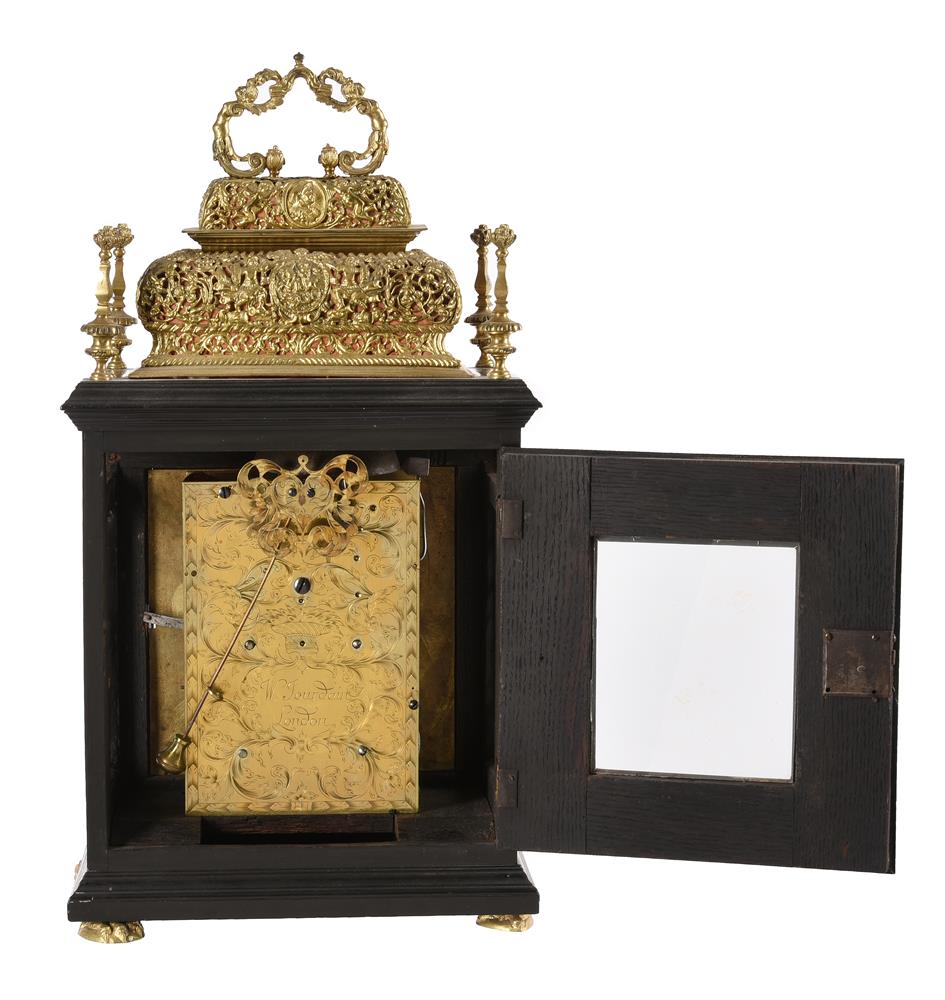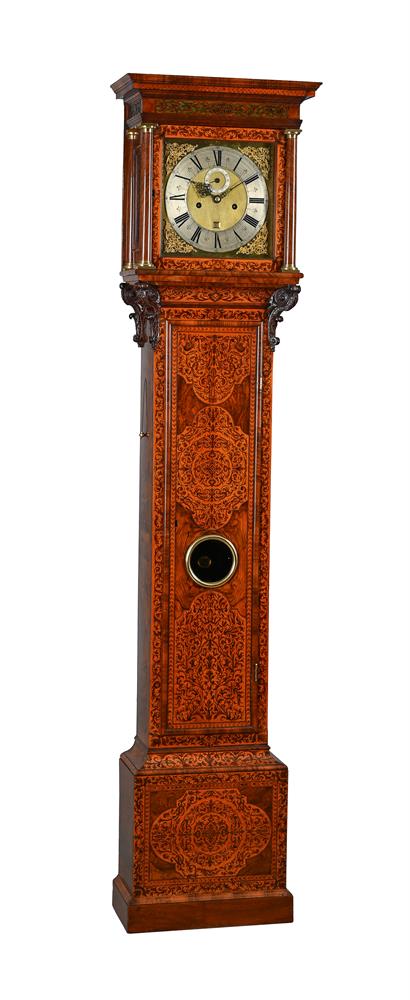A fine William III silver pair-cased verge pocket watch Daniel Quare London, circa 1695 The gilt full plate single fusee verge movement with four Egyptian pillars incorporating foliate-pierced galleries pinned through the backplate, scroll-pierced stop-iron block and sprung three-arm steel balance with Tompion type regulation, the backplate with fine symmetrical foliate scroll pierced and engraved balance cock with herringbone bordered rim and conforming pierced broad foot flanked by silvered regulation disc with adjacent applied scroll pierced infill opposing signature Quare, London, the pillar-plate fitted with circular silver champleve dial with scroll-chased signature cartouches engraved Quare, London to the matted centre within Roman numeral chapter ring with lozenge half hour markers and Arabic cartouche five minute numerals to outer track, with later blued steel beetle and poker hands and in plain silver inner case with suspension post and ring at twelve o'clock, with an outer case decorated with pique work scroll designs into leather covered brass within moulded silvered brass hinge plates and bezel-edge, the dial 41mm diameter; the inner case 48mm diameter; the outer case 55mm diameter. Daniel Quare is an important maker who is recorded on Loomes, Brian The Clockmakers of Great Britain 1286-1700 as born in Somerset circa 1647/8; by 1671 he had moved to London as he was admitted as a Free Brother to the Clockmakers' Company in April of that year. Quare initially worked in St. Martin's Le Grand, London (where he married in 1776) later moving to Allhallows, Lombard Street in 1681, before finally relocating to Exchange Alley where he is believed to have taken-on the former premises of Robert Seignior in around 1686. Quare was selected as a member of the Court of Assistants in 1698 later becoming Master in 1708. In 1709 he is believed to have taken his former apprentice, Stephen Horseman, into partnership which presumably lasted until Quare's death in 1724. Daniel Quare was a fine and inventive maker who supplied clocks and barometers to significant European Royal and aristocratic clients. As a committed Quaker he refused to sign the Oath of Allegiance in 1697, however as a much respected maker, he was still able to discreetly supply the court of William III. In around 1680 Quare made repeating watches to his own design which eventually lead him to dispute a conflicting patent filed by Edward Barlow in 1686; the resulting exchange two years to resolve. Condition report disclaimer
A fine William III silver pair-cased verge pocket watch Daniel Quare London, circa 1695 The gilt full plate single fusee verge movement with four Egyptian pillars incorporating foliate-pierced galleries pinned through the backplate, scroll-pierced stop-iron block and sprung three-arm steel balance with Tompion type regulation, the backplate with fine symmetrical foliate scroll pierced and engraved balance cock with herringbone bordered rim and conforming pierced broad foot flanked by silvered regulation disc with adjacent applied scroll pierced infill opposing signature Quare, London, the pillar-plate fitted with circular silver champleve dial with scroll-chased signature cartouches engraved Quare, London to the matted centre within Roman numeral chapter ring with lozenge half hour markers and Arabic cartouche five minute numerals to outer track, with later blued steel beetle and poker hands and in plain silver inner case with suspension post and ring at twelve o'clock, with an outer case decorated with pique work scroll designs into leather covered brass within moulded silvered brass hinge plates and bezel-edge, the dial 41mm diameter; the inner case 48mm diameter; the outer case 55mm diameter. Daniel Quare is an important maker who is recorded on Loomes, Brian The Clockmakers of Great Britain 1286-1700 as born in Somerset circa 1647/8; by 1671 he had moved to London as he was admitted as a Free Brother to the Clockmakers' Company in April of that year. Quare initially worked in St. Martin's Le Grand, London (where he married in 1776) later moving to Allhallows, Lombard Street in 1681, before finally relocating to Exchange Alley where he is believed to have taken-on the former premises of Robert Seignior in around 1686. Quare was selected as a member of the Court of Assistants in 1698 later becoming Master in 1708. In 1709 he is believed to have taken his former apprentice, Stephen Horseman, into partnership which presumably lasted until Quare's death in 1724. Daniel Quare was a fine and inventive maker who supplied clocks and barometers to significant European Royal and aristocratic clients. As a committed Quaker he refused to sign the Oath of Allegiance in 1697, however as a much respected maker, he was still able to discreetly supply the court of William III. In around 1680 Quare made repeating watches to his own design which eventually lead him to dispute a conflicting patent filed by Edward Barlow in 1686; the resulting exchange two years to resolve. Condition report disclaimer















Testen Sie LotSearch und seine Premium-Features 7 Tage - ohne Kosten!
Lassen Sie sich automatisch über neue Objekte in kommenden Auktionen benachrichtigen.
Suchauftrag anlegen